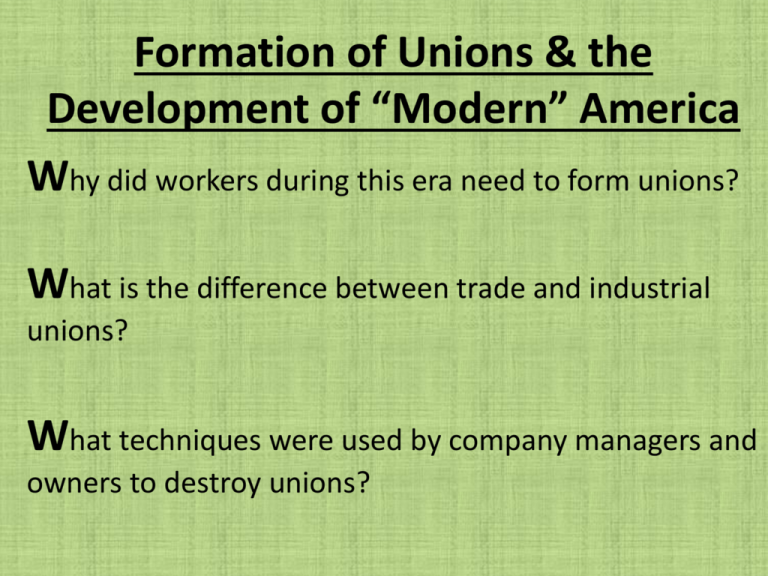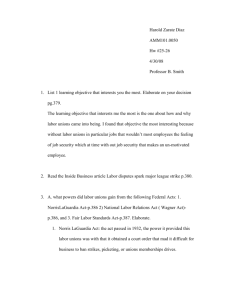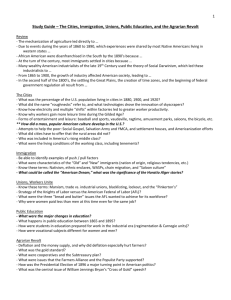Unions, Eduation Reform, and the Modern America
advertisement

Formation of Unions & the Development of “Modern” America Why did workers during this era need to form unions? What is the difference between trade and industrial unions? What techniques were used by company managers and owners to destroy unions? Need for Unions: - Responding to deflation - Better pay and working conditions Trade and Industrial unions: - Or craft workers; these were skilled workers - Industrial – every other worker in a factory Efforts to destroy unions: - “Blacklisting” – list of people not to be hired - Lockouts – locking workers out of factory and refusal to pay - “Pinkerton’s” – a security agency, often hired to stop unions What is the basis of Marxism? What is the four-step process Marx believed would eventually occur in capitalist societies? What were the four things the Knights of Labor argued for? Marxism? - “Class struggle” is the basic force shaping society How society progresses, according to Marxism: 1 – Workers revolt 2 – Seize control of factories 3 – Overthrow the government 4 – After “the revolution,” government would seize all private property and create a socialist society Knights of Labor: - Welcomed African-Americans & women - Argued for the following: 1 – Eight-hour work day 2 – Equal pay for women 3 – Abolition of child labor 4 – Creation of worker-owned factories Great Railroad Strike (1877) Haymarket Riot (1886) What were the “bread and butter” union issues? What percentage of the workforce were women, what jobs did women do, why were women paid less than men, and how did unions feel about women? Homestead Strike (1892) Pullman Strike (1893) - Pullman Company – made sleeping cars - George Pullman, created a “company town” American Federation of Labor (AFL) - Promoted interest of craft labor - Advocated “bread and butter” issues - (1) wages, (2) working hours, and (3) working conditions Women in the workforce: - 18% of the total labor force - What women did in workforce: - 1/3 as domestic servants - 1/3 as teachers, nurses, and sales clerks - Many were garment workers and food-processing plants - It was assumed women had a man supporting them at home. ** Most unions excluded women. Urban Planning A - s cities grew, development of new career = the urban planner / civil engineer - Creating “havens” in the middle of busy cities Frederick Law Olmsted created New York’s Central Park Daniel Burnham created Chicago’s Navy Pier Expanding Public Education W illiam Torrey Harris, an educational reformer, believed public schools were a … “great instrument to lift all classes of people into … civilized life.” - Schools are … - training ground for employment & citizenship - key to economic security - best opportunity to assimilate new immigrants Expanding Public Education (continued) - Making school mandatory … B - etween 1865 and 1895, states passed laws requiring 12 to 16 weeks of school attendance between the ages of 8 and 12. K - indergartens increase in number from 200 in 1880 to 3,000 in 1900. Expanding Public Education (continued) - Growth of high schools … L - oyal to the capitalist system & P - repared for work in the industrial era, with the following practices: - (1) Regimentation … - (2) Carnegie units … Expanding Public Education (continued) C - urriculum changes to include … A - nd vocational subjects … different ones for women and men A - “ mericanization” of immigrants… Revolution in Printing R - evolution in printing led to an increase in literacy to 90% - Various advances in printing … - Linotype - Paper from pulp - Printing on both sides of paper I Linotype Machine - ncreased proliferation of various print media … - Mass circulation of newspapers … Pulitzer vs. Randolph Hearst More Leisure and Snacks - Susan B. Anthony once said, … “I think bicycling has done more to emancipate the woman than anything else in the world … it gives women a feeling of freedom and self-reliance.” Bicycle becomes safer … - Tennis arrives to America in 1874 … - Hershey’s Chocolate Bar … - Coca-Cola … - Swift Safety Bicycle Rural Free Delivery and The Catalog - Montgomery Ward Catalog - Sears-Roebuck Catalog - Rural Free Delivery A New “Mass” or “Popular” American Culture ** Why A Popular, Mass Culture? ** Why A Popular, Mass Culture? G - (1) reater Urban culture - Greater concentration of people L - (2) ess work-time - (3) - The average work week declines: Mandatory Public Education - 69.7 hours per week in 1860 (includes farming) - 61.7 hours in 1890 - 54.9 hours in 1910 Rise of Marketing - (5) More Discretionary Income - (6) Greater Publishing - (4) * GNP per capita - 1870 - $531 - 1890 - $836 - 1910 - $1,299 * Percentage of Income on Food - 1870 - 32% - 1890 - 29% - 1910 - 25%







